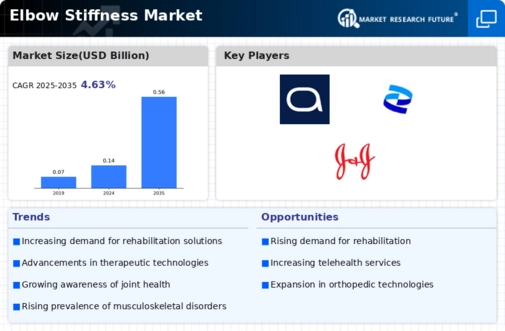Market Share
Elbow Stiffness Market Share Analysis
The medical device industry's Elbow Stiffness market targets elbow-impaired persons. Also, this market provides remedies for these folks. Businesses utilize several market share positioning strategies to gain market share in this competitive environment. Businesses vie for market dominance by differentiating their products. Technologically advanced braces, rehabilitation gadgets, and minimally invasive surgeries are being developed to address elbow stiffness. Businesses may become industry leaders and attract more customers by offering unique and efficient products. Successful market positioning requires good marketing and education. Businesses spend in concentrated marketing to end-users and healthcare experts like orthopedic surgeons and physical therapists. Educational efforts on elbow stiffness causes and treatments might help a company become an industry leader. Businesses often employ global expansion strategies to increase market share. This includes penetrating untapped markets and establishing a presence in elbow-related disease hotspots. Companies may develop and increase their market position by reaching more potential customers. Establishing strong relationships with healthcare specialists is crucial for market positioning. These firms communicate with orthopedic doctors and rehabilitation professionals to get market insights and product endorsements. Both professionals and consumers gain reputation and trust from these exchanges. To lead the elbow stiffness sector, research and development must be constant. Companies invest in cutting-edge technology and materials to boost product efficiency and comfort. R&D makes a firm competitive and industry leader. Successful companies recognize and prioritize patient needs. Provide customizable solutions that match each person's requirements. Businesses that meet patient needs may build a loyal customer base and stand out from competitors. Elbow stiffness companies often merge, acquire, and form strategic collaborations. Firms typically develop strategic alliances or purchase comparable companies to expand their product ranges and market position. Such partnerships may boost operational efficiency and provide customers a more comprehensive product. Some companies use cost leadership to position themselves in the market. Streamlining production processes, gaining favorable supplier agreements, and achieving economies of scale allow companies to provide high-quality elbow stiffness solutions at competitive prices. This may be attractive in a cost-sensitive sector. Iterative development based on client feedback leads to effective market positioning. Businesses that actively seek input from healthcare professionals and end-users may adapt their products and strategies to market changes to guarantee long-term success and a strong elbow stiffness market position.

















Leave a Comment